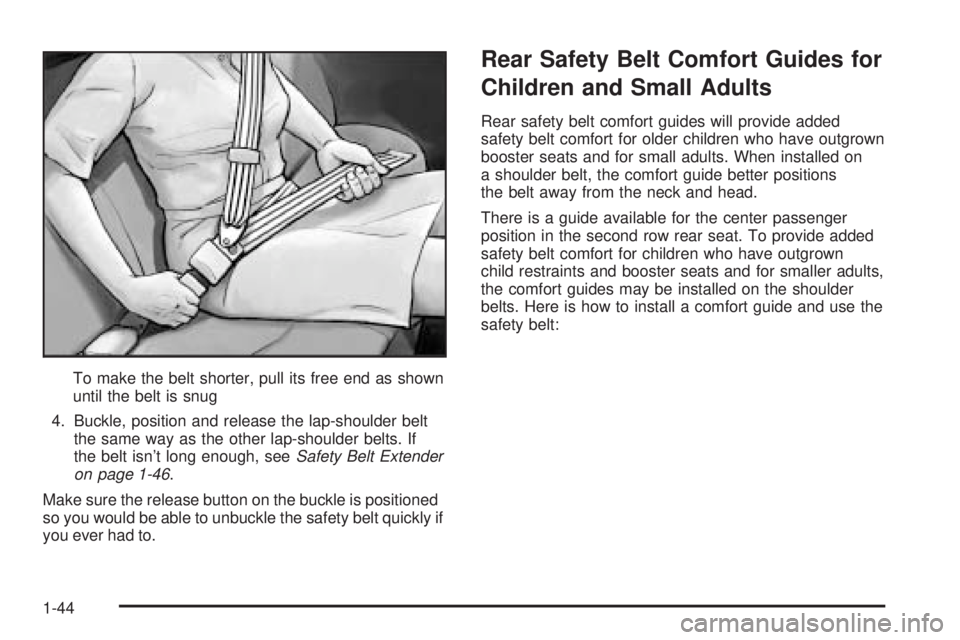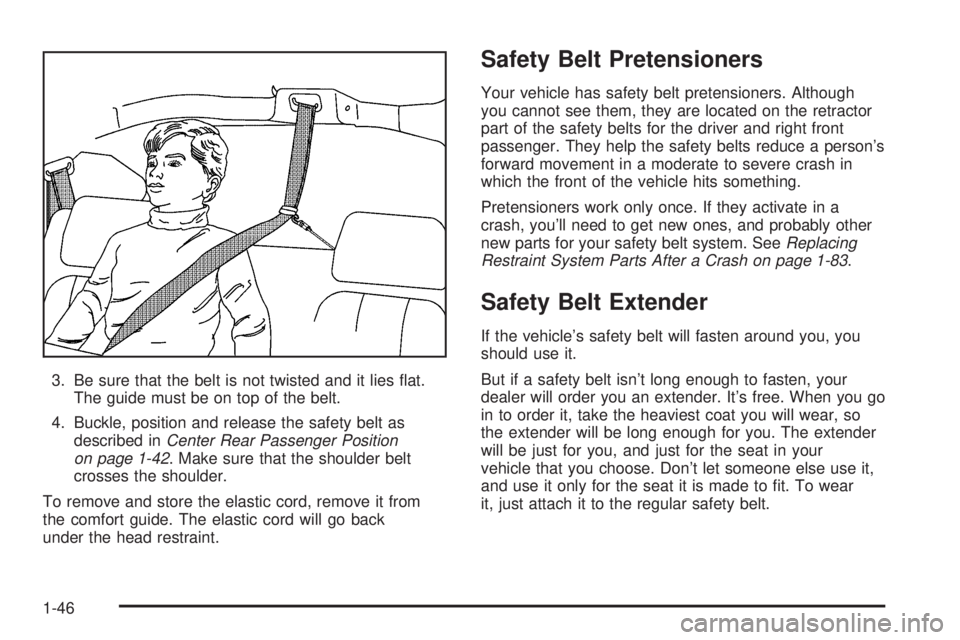Page 46 of 486
3. To make the lap part tight, pull down on the buckle
end of the belt as you pull up on the shoulder part.The lap part of the belt should be worn low and snug
on the hips, just touching the thighs. In a crash, this
applies force to the pelvic bones. And you’d be less
likely to slide under the lap belt. If you slid under it,
the belt would apply force at your abdomen. This
could cause serious or even fatal injuries. The
shoulder belt should go over the shoulder and across
the chest. These parts of the body are best able to
take belt restraining forces.
1-40
Page 47 of 486

The safety belt locks if there’s a sudden stop or a
crash, or if you pull the belt very quickly out of
the retractor.
Each position next to the windows in the second
row has a shoulder belt height adjuster. Move
the shoulder belt adjuster to the height that is right
for you.
To move it down, push down on the button and
move the height adjuster to the desired position.
You can move the height adjuster up just by pushing
up on the shoulder belt guide. After you move the
adjuster to where you want it, try to move it
down without pushing the button down to make
sure it has locked into position.
Adjust the height so that the shoulder portion of the
belt is centered on your shoulder. The belt should
be away from your face and neck, but not falling off
your shoulder.
{CAUTION:
You can be seriously hurt if your shoulder belt
is too loose. In a crash, you would move
forward too much, which could increase injury.
The shoulder belt should �t against your body.To unlatch the belt, just push the button on the
buckle.
1-41
Page 48 of 486
Center Rear Passenger Position
Lap-Shoulder Belt
If your vehicle has a bench seat, someone can sit in the
center position.
When you sit in the center seating position, you have a
lap safety belt, which has no retractor. You also
have a shoulder belt, which has a retractor. In order to
have the protection of the shoulder belt, you must
�rst connect it to the lap belt.1. Remove the shoulder belt from its stowage location
in the roof and pull it all the way down to the lap belt.
1-42
Page 49 of 486
2. Insert the metal knob on the shoulder belt into the
keyhole on the lap belt buckle as shown. Be sure to
slide the shoulder belt part into the keyhole until
it locks into place.3. To make the lap belt longer, tilt the latch plate and
pull it along the belt.
1-43
Page 50 of 486

To make the belt shorter, pull its free end as shown
until the belt is snug
4. Buckle, position and release the lap-shoulder belt
the same way as the other lap-shoulder belts. If
the belt isn’t long enough, seeSafety Belt Extender
on page 1-46.
Make sure the release button on the buckle is positioned
so you would be able to unbuckle the safety belt quickly if
you ever had to.
Rear Safety Belt Comfort Guides for
Children and Small Adults
Rear safety belt comfort guides will provide added
safety belt comfort for older children who have outgrown
booster seats and for small adults. When installed on
a shoulder belt, the comfort guide better positions
the belt away from the neck and head.
There is a guide available for the center passenger
position in the second row rear seat. To provide added
safety belt comfort for children who have outgrown
child restraints and booster seats and for smaller adults,
the comfort guides may be installed on the shoulder
belts. Here is how to install a comfort guide and use the
safety belt:
1-44
Page 51 of 486
For second row center position do the following:
1. Remove the elastic cord from under the head
restraint of the second row driver’s side position.2. Attach the elastic cord to the comfort guide on the
center passenger shoulder belt. Second Row Center Position
1-45
Page 52 of 486

3. Be sure that the belt is not twisted and it lies �at.
The guide must be on top of the belt.
4. Buckle, position and release the safety belt as
described inCenter Rear Passenger Position
on page 1-42. Make sure that the shoulder belt
crosses the shoulder.
To remove and store the elastic cord, remove it from
the comfort guide. The elastic cord will go back
under the head restraint.
Safety Belt Pretensioners
Your vehicle has safety belt pretensioners. Although
you cannot see them, they are located on the retractor
part of the safety belts for the driver and right front
passenger. They help the safety belts reduce a person’s
forward movement in a moderate to severe crash in
which the front of the vehicle hits something.
Pretensioners work only once. If they activate in a
crash, you’ll need to get new ones, and probably other
new parts for your safety belt system. SeeReplacing
Restraint System Parts After a Crash on page 1-83.
Safety Belt Extender
If the vehicle’s safety belt will fasten around you, you
should use it.
But if a safety belt isn’t long enough to fasten, your
dealer will order you an extender. It’s free. When you go
in to order it, take the heaviest coat you will wear, so
the extender will be long enough for you. The extender
will be just for you, and just for the seat in your
vehicle that you choose. Don’t let someone else use it,
and use it only for the seat it is made to �t. To wear
it, just attach it to the regular safety belt.
1-46
Page 53 of 486
Child Restraints
Older Children
Older children who have outgrown booster seats should
wear the vehicle’s safety belts.
Q:What is the proper way to wear safety belts?
A:If possible, an older child should wear a
lap-shoulder belt and get the additional restraint a
shoulder belt can provide. The shoulder belt
should not cross the face or neck. The lap belt
should �t snugly below the hips, just touching the
top of the thighs. It should never be worn over
the abdomen, which could cause severe or even
fatal internal injuries in a crash.
Accident statistics show that children are safer if they
are restrained in the rear seat.
In a crash, children who are not buckled up can strike
other people who are buckled up, or can be thrown
out of the vehicle. Older children need to use safety
belts properly.
1-47